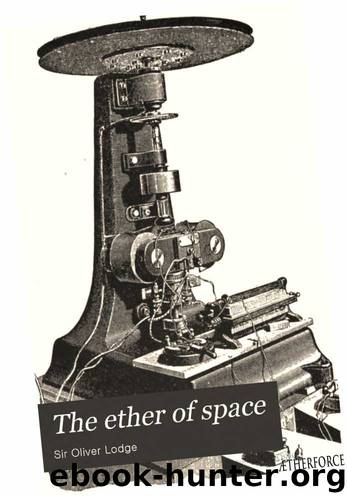The Ether of Space by Oliver Lodge

Author:Oliver Lodge [Lodge, Oliver]
Language: eng
Format: epub
Tags: Science / Alternative
Published: 0101-01-01T00:00:00+00:00
VI
ETHERIAL DENSITY
THIS leads us to enter upon the question of whether it is possible to determine with any approach to accuracy the actual density or massiveness of the ether of space, compared with those forms of matter to which our senses have made us accustomed.
The arguments on which an estimate may be made of the density or massiveness of the ether as compared with that of matter depend on the following considerations, the validity of which again is dependent upon an electrical theory of matter. In this theory, or working hypothesis, an assumption has to be made: but it is one for which there is a large amount of justification, and the reasons for it are given in many books— among others in my book on Electrons, and likewise at the end of the new edition of Modern Views of Electricity, also in my Romanes Lecture, published by the Clarendon Press in 1903. Put briefly, the assumption is that matter is composed, in some way or other, of electrons; which ...
... But without repeating arguments here, it will suffice to say that although the estimates may be made in various ways, differing entirely from each other, yet the resulting differences are only slight; the calculated densities come out all of the same order of magnitude—namely, something comparable to 1012 c.g.s. units; that is to say, a million million grammes per cubic centimeter, or, in other words, a thousand tons to the cubic millimeter.
But, throughout, we have seen reason to assert that the ether is incompressible; arguments for this are given in Modern Views of Electricity, Chapter I. And, indeed, the fundamental medium filling all space, if there be such, must, in my judgment, be ultimately incompressible; otherwise it would be composed of parts, and we should have to seek for something still more fundamental to fill the interstices.
The ether being incompressible, and an electron being supposed composed simply and solely of ether, it follows that it cannot be either a condensation or a rarefaction of that material, but must be some singularity of structure, or some portion otherwise differentiated. It might, for instance, be something analogous to a vortex ring, differentiated kinetically—i.e., by reason of its rotational motion, from the remainder of the ether; or it might be differentiated statically, and be something which would have to be called a strain-centre or a region of twist, or something which cannot be very clearly at present imagined with any security; though various suggestions have been made in that direction.
The simplest plan for us is to think of it somewhat as we think of a knot on a piece of string. The knot differs in no respect from the rest of the string, except in its tied-up structure; it is of the same density with the rest, and yet it is differentiated from the rest; and, in order to cease to be a knot, would have to be untied—a process which as yet we have not yet learned how to apply to an electron.
Download
This site does not store any files on its server. We only index and link to content provided by other sites. Please contact the content providers to delete copyright contents if any and email us, we'll remove relevant links or contents immediately.
The Complete Stick Figure Physics Tutorials by Allen Sarah(7135)
Secrets of Antigravity Propulsion: Tesla, UFOs, and Classified Aerospace Technology by Ph.D. Paul A. Laviolette(4974)
Thing Explainer by Randall Munroe(3782)
The River of Consciousness by Oliver Sacks(3414)
The Order of Time by Carlo Rovelli(3072)
How To by Randall Munroe(2911)
I Live in the Future & Here's How It Works by Nick Bilton(2840)
A Brief History of Time by Stephen Hawking(2819)
What If?: Serious Scientific Answers to Absurd Hypothetical Questions by Randall Munroe(2542)
The Great Unknown by Marcus du Sautoy(2532)
Midnight in Chernobyl by Adam Higginbotham(2386)
Blockchain: Ultimate Step By Step Guide To Understanding Blockchain Technology, Bitcoin Creation, and the future of Money (Novice to Expert) by Keizer Söze(2379)
Networks: An Introduction by Newman Mark(2264)
The Meaning of it All by Richard Feynman(2213)
Easy Electronics by Charles Platt(2205)
The Tao of Physics by Fritjof Capra(2163)
Midnight in Chernobyl: The Untold Story of the World's Greatest Nuclear Disaster by Adam Higginbotham(2074)
When by Daniel H Pink(2020)
Introducing Relativity by Bruce Bassett(2018)
